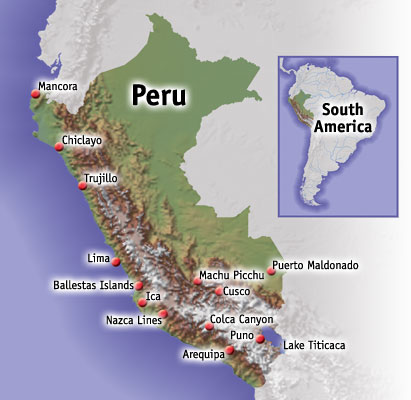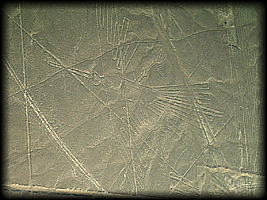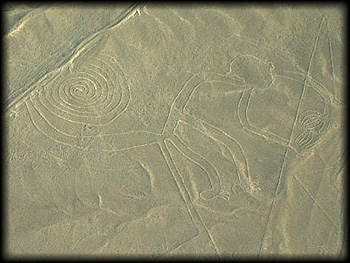 |
www.shejapan.com > World Heritages > Nazca Lines
Quiz:
|
|
|
|
今回、世界遺産を調べるに当たって、まず頭に浮かんできた場所が以前から一度行ってみたいと思っていたナスカの地上絵でした。神秘的であり、人智を超えた力が働いているとも言われているこの世界遺産を調べていくにつれ、より一層引き込まれていきました。今までHTMLを使ったことがなかったのですが、WEBページ製作を通じて使えるようになって、非常に良かったです。
青山学院大学 経済学部経済学科 鈴木 孝徳
2. What sea is Bergen facing?

Brief description:
The Nazca Lines are located in the arid Peruvian coastal plain, some 400 km south of Lima, the geoglyphs of Nasca and the pampas of Jumana cover about 450 km2. These lines, which were scratched on the surface of the ground between 500 B.C. and A.D. 500, are among archaeology's greatest enigmas because of their quantity, nature, size and continuity. The geoglyphs depict living creatures, stylized plants and imaginary beings, as well as geometric figures several kilometres long. They are believed to have had ritual astronomical functions.
Nazca Lines
 The Nazca lines cannot be recognized as coherent figures except from the air. Since it is presumed the Nazca people could never have seen their work from this vantage point, there has been much speculation on the builders' abilities and motivations.
The Nazca lines cannot be recognized as coherent figures except from the air. Since it is presumed the Nazca people could never have seen their work from this vantage point, there has been much speculation on the builders' abilities and motivations.
 Since their discovery, various theories have been proposed regarding the methods and motivations underlying the lines' construction. The archaeological explanation as to who made them and how is widely accepted; namely that the Nazca people made the lines using simple tools and surveying equipment. Wooden stakes in the ground at the end of some lines (which were used to carbon-date the figures) and ceramics found on the surface support this theory. The lines were made by removing the iron oxide coated pebbles which cover the surface of the Nazca desert. When the gravel is removed, they contrast sharply with the light-colored earth underneath. (1)There are several hundred simple lines and geometric patterns on the Nazca plateau, as well as over seventy curvilinear animal, insect, and human figures.
Since their discovery, various theories have been proposed regarding the methods and motivations underlying the lines' construction. The archaeological explanation as to who made them and how is widely accepted; namely that the Nazca people made the lines using simple tools and surveying equipment. Wooden stakes in the ground at the end of some lines (which were used to carbon-date the figures) and ceramics found on the surface support this theory. The lines were made by removing the iron oxide coated pebbles which cover the surface of the Nazca desert. When the gravel is removed, they contrast sharply with the light-colored earth underneath. (1)There are several hundred simple lines and geometric patterns on the Nazca plateau, as well as over seventy curvilinear animal, insect, and human figures.
 The area encompassing the lines is nearly 500 square kilometers (200 square miles), and the largest figures can be nearly 900 feet (270 meters) long. The lines persist due to the extremely dry, windless, and constant climate of the Nazca region: the Nazca desert is one of the driest on Earth and maintains a temperature around 25°C (77°F) all year round, and the lack of wind has helped keep the lines uncovered to the present day and possibly the future.
There is scant evidence concerning why the figures were built, so the Nazca people's motivation remains the lines' most persistent mystery. Many scholars believe that their motivation was religious, making images that only gods in the sky could see clearly. Kosok and Reiche advanced one of the earliest reasons given for the Nazca Lines: that they were intended to point to the places on the distant horizon where the Sun and other celestial bodies rose or set. This hypothesis was evaluated by two different experts in archaeoastronomy, Gerald Hawkins and Anthony Aveni, and they both concluded that there was insufficient evidence to support an astronomical explanation.
The area encompassing the lines is nearly 500 square kilometers (200 square miles), and the largest figures can be nearly 900 feet (270 meters) long. The lines persist due to the extremely dry, windless, and constant climate of the Nazca region: the Nazca desert is one of the driest on Earth and maintains a temperature around 25°C (77°F) all year round, and the lack of wind has helped keep the lines uncovered to the present day and possibly the future.
There is scant evidence concerning why the figures were built, so the Nazca people's motivation remains the lines' most persistent mystery. Many scholars believe that their motivation was religious, making images that only gods in the sky could see clearly. Kosok and Reiche advanced one of the earliest reasons given for the Nazca Lines: that they were intended to point to the places on the distant horizon where the Sun and other celestial bodies rose or set. This hypothesis was evaluated by two different experts in archaeoastronomy, Gerald Hawkins and Anthony Aveni, and they both concluded that there was insufficient evidence to support an astronomical explanation.
 Notwithstanding Gerald Hawkins' and Anthony Aveni's dismissal of an astronomical explanation of the Nazca Lines and geoglyphs, astronomer Robin Edgar has theorized that the Nazca Lines, particularly the biomorph geoglyphs that depict animals, human figures, birds and "flowers" are almost certainly an ancient response to the so-called "Eye of God" that is manifested in the sky during a total solar eclipse. (2)An unusual series of total solar eclipses over southern Peru coincided with the time period during which the Nazca Lines and geoglyphs were created. The totally eclipsed sun distinctly resembles the pupil and iris of a gigantic eye looking down from the sky thus providing an explanation as to why the Nazca Indians created gigantic geoglyph artworks that are best viewed by an "Eye in the Sky".[citation needed]
Notwithstanding Gerald Hawkins' and Anthony Aveni's dismissal of an astronomical explanation of the Nazca Lines and geoglyphs, astronomer Robin Edgar has theorized that the Nazca Lines, particularly the biomorph geoglyphs that depict animals, human figures, birds and "flowers" are almost certainly an ancient response to the so-called "Eye of God" that is manifested in the sky during a total solar eclipse. (2)An unusual series of total solar eclipses over southern Peru coincided with the time period during which the Nazca Lines and geoglyphs were created. The totally eclipsed sun distinctly resembles the pupil and iris of a gigantic eye looking down from the sky thus providing an explanation as to why the Nazca Indians created gigantic geoglyph artworks that are best viewed by an "Eye in the Sky".[citation needed]
調べてみるとやはり、期待を裏切らず魅力的なものであり、ますます行ってみたくなりました。また、何度も写真を見て資料を読んでみても、謎は深まるばかりで、人は謎めいたものに興味を見出す生き物なのだとつくづく感じました。
Notes
coherent
直線の
archaeological
考古学の
equipment
装備
pebble
小石
gravel
砂利
scant
不十分な
persistent
永続的な
Kosok
ナスカの地上絵の発見者
Raiche
ドイツの数学者
celestial
神聖な
gigantic
巨大な
wikipedia
discoverly channel
map of figure
google map
www.shejapan.com
> World
Heritages > Nazca lines
© 2005 SHEJapan.com